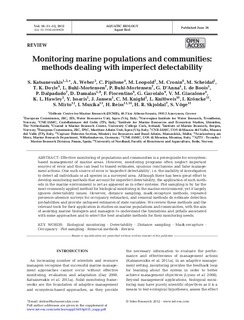Monitoring marine populations and communities: methods dealing with imperfect detectability
Katsanevakis, Stelios; Weber, Anke; Pipitone, Carlo; Leopold, Mardik; Cronin, Michelle; Scheidat, Meike; Doyle, Thomas K.; Buhl-Mortensen, Lene; Buhl-Mortensen, Pål; D’Anna, Giovanni; de Boois, I.J.; Dalpadado, Padmini; Damalas, Dimitrios; Fiorentino, Fabio; Garofalo, Germana; Giacalone, Vincenzo Maximiliano; Hawley, Kate; Issaris, Yiannis; Jansen, J.; Knight, Carolyn; Knittweis, Leyla; Kröncke, Ingrid; Mirto, Simone; Muxika, Iñigo; Reiss, Henning; Skjoldal, Hein Rune; Vöge, Sandra
Journal article, Peer reviewed
Permanent lenke
http://hdl.handle.net/11250/109273Utgivelsesdato
2012-06-26Metadata
Vis full innførselSamlinger
- Articles [3009]
Originalversjon
http://dx.doi.org/10.3354/ab00426Sammendrag
Effective monitoring of populations and communities is a prerequisite for ecosystembased
management of marine areas. However, monitoring programs often neglect important
sources of error and thus can lead to biased estimates, spurious conclusions and false management
actions. One such source of error is ‘imperfect detectability’, i.e. the inability of investigators
to detect all individuals or all species in a surveyed area. Although there has been great effort to
develop monitoring methods that account for imperfect detectability, the application of such methods
in the marine environment is not as apparent as in other systems. Plot sampling is by far the
most commonly applied method for biological monitoring in the marine environment, yet it largely
ignores detectability issues. However, distance sampling, mark-recapture methods, repeated
presence-absence surveys for occupancy estimation, and removal methods do estimate detection
probabilities and provide unbiased estimates of state variables. We review these methods and the
relevant tools for their application in studies on marine populations and communities, with the aim
of assisting marine biologists and managers to understand the limitations and pitfalls associated
with some approaches and to select the best available methods for their monitoring needs.
